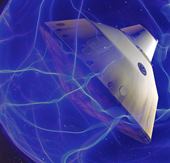Magnetohydrodynamic flow control during reentry

Throughout the history of space flight, numerous missions have required space vehicles to travel into planetary atmospheres. This not only true for human transport vehicles, but also for sample-return capsules, planetary landers and impactors.
When entry vehicles travel through the atmosphere at hypersonic velocities, a shock wave is created which brings the gas behind the shock to high temperatures. If this temperature is sufficiently high, flow ionization occurs and a so-called plasma is formed. As this gas is charged, electromagnetic interaction by means of an external magnetic field can alter the properties of the incoming airflow. The combination of an external magnetic field with the movement of charged particles around the capsule, also known as plasma current, will generate a Lorentz force that pushes the shock layer further away from the capsule (see figure). This technique is known as Magneto Hydro-Dynamic (MHD) flow control.
![Schematic view of the Lorentz force generation around a blunt object (Taken from \[1\])](/gsp/ACT/images/projects/PRO_reentry_otsu.png)
During the reentry phase, spacecraft experiences large aerodynamic and thermal loads that constraint the vehicle design. Entry vehicles have been traditionally equipped with passive thermal protection systems (TPS) which typically consist of ablative heat-shields and heat-resistant materials. Previous studies have shown that MHD flow control is a potential active TPS technology, since it is capable of reducing the thermal loads typically experienced during atmospheric entry [2]. Furthermore, MHD flow control could bring benefits in terms of vehicle controllability and re-usability.
In a short study within the Advanced Concepts Team, existing literature on this concept was combined to estimate the impact on the re-entry trajectory. In particular, the interest was to explore the maximum velocity achievable for direct entry. Using a simplified model of the entry dynamics, in combination with an analytical approximation of the MHD interaction, a trajectory analysis could be performed under varying levels of magnetic field strength. One of the main results was that the magnitude of the entry velocity plays a significant impact on the effectiveness of the MHD flow control system. If the entry velocity is too low, the flow will not reach a sufficient energy level for ionization to occur, and if the velocity is too high, the induced electromagnetic forces lead to an increased mechanical load with respect to a reentry with no MHD flow control. Using optimal control techniques, trajectories that limit the peak aerodynamic load and heat flux are obtained through a combination of attitude control and magnetic field strength control. The resulting trajectories show how the MHD system “augments” the lift and drag forces in the early flight, effectively reducing the aerothermal loads by means of a longer deceleration phase at high altitude (low density atmosphere). Once the velocity has decreased sufficiently for plasma formation to cease, a normal reentry trajectory can be performed.
References
- H. Otsu, H. Shizuoka, A.Matsuda, T. Abe, D. Konigorski, Feasibility Study on the Flight Demonstration for a Reentry Vehicle with theMagnetic Flow Control System, AIAA 2006-3566, 2006.
- T. Yoshino, T. Fujino, M. Ishikawa, Possibility of Thermal Protection in Earth Re-entry Flight by MHD Flow Control with Air-Core Circular Magnet, Institute of Electrical Engineers of Japan, 2009.